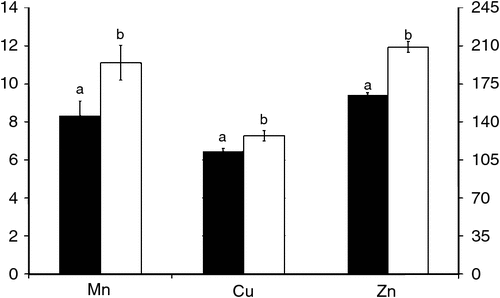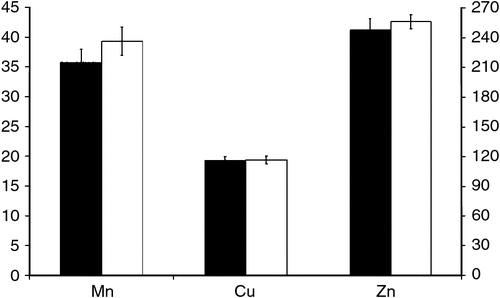Amino acid complexed minerals in the diet increased mineral content in the hair and hoof of growing gilts
T. L. Muller A C , R. J. E. Hewitt A , D. N. D’Souza A and R. J. van Barneveld BA SunPork Solutions, Loganholme, QLD 4129.
B SunPork Group, Murarrie, QLD 4172.
C Corresponding author. Email: tracy.muller@sunporkfarms.com.au
Animal Production Science 57(12) 2457-2457 https://doi.org/10.1071/ANv57n12Ab063
Published: 20 November 2017
Trace minerals play an important role in improving claw health and integrity thus reducing the incidence of lameness in pigs. Trace minerals that have been observed to have an important role in claw keratin formation include zinc (Zn), manganese (Mn) and copper (Cu). In particular, Zn and Mn are two trace minerals supplemented into livestock diets, each play a role in keratinisation of the hoof epidermis (Tomlinson et al. 2004). It has been stated that much of the inorganic Zn included in pig diets is excreted (Acda and Chae 2002) due to its low bioavailability; however, research has found bioavailability of trace minerals can be improved by binding them to organic ligands where one metal ion is bound to one amino acid ion. Muller et al. (2015) showed the ability to measure content through trace mineral analysis, using a chemical traceability system known as Physi-Trace®, of hair in mature sows. This experiment aimed to determine if trace mineral content was comparable within the hoof and hair, such that hair analysis could be a marker in the context of mineral bioavailability for hoof health.
Fifty female pigs were selected at weaning and randomly allocated (21 days, mean weight 5.4 ± 0.5 kg (mean ± s.d.)) into three dietary treatment groups (n = 25) and maintained through to slaughter (~21 weeks of age). Isoenergetic and isonitrogenous diets were fed to treatment groups throughout the experiment containing a base vitamin/mineral premix (120 ppm Zn for ZnSO4, 50 ppm Mn from MnO, 15 ppm Cu from CuSO4) with the inorganic treatment group receiving an additional 750 g/t of the premix. Amino acid complex (AAC) treatment received 750 g/t of Availa®Sow (Zinpro Corp., Eden Prairie, MN, USA) delivering an additional 50 ppm Zn, 20 ppm Mn and 10 ppm Cu from amino acid complexed minerals. Pigs were held in a group housing system with feed and water offered ad libitum. The left and right rump was shaved of all hair at the start of the experiment (Muller et al. 2015) and a pooled hair sample was taken before slaughter at 21 weeks. Hoof samples, from each of the rear and front limb, were also collected at 21 weeks, with both hair and hoof samples analysed for their trace mineral content. Data were analysed using the Univariate GLM and correlation procedures (Genstat 15, VSN International, Hemel Hempstead, UK).
Although not significant, and correlations between hoof and hair samples were not found (P < 0.05), levels of Zn and Mn appear to be higher in the hair of pigs fed the AAC diet, consistent with content seen in the hoof (Figs 1, 2). With these results, it is uncertain whether trace minerals were supplemented at an increased rate above that required physiologically and therefore, whether this may hold some validation for using hair analysis to predict levels of content in the hoof for future work.

|

|
References
Acda S, Chae B (2002) Pakistan Journal of Nutrition 1, 25–30.| Crossref | GoogleScholarGoogle Scholar |
Muller TL, Hewitt RJE, van Barneveld RJ (2015) Animal Production Science 55, 1547
| Crossref | GoogleScholarGoogle Scholar |
Tomlinson DJ, Mülling CH, Fakler TM (2004) Journal of Dairy Science 87, 797–809.
| Crossref | GoogleScholarGoogle Scholar |
Supported in part by Australian Pork Limited.


